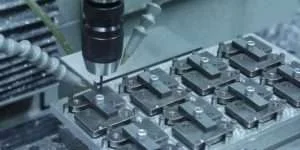La industria manufacturera depende en gran medida de la precisión, la exactitud y la eficacia. El mecanizado CNC es una tecnología revolucionaria para lograr todo esto rápidamente. Este método automatizado produce componentes intrincados de la máquina con facilidad y flexibilidad.
Su capacidad para lograr precisión depende de muchas herramientas y son necesarias para manipular una pieza de trabajo mientras se corta o procesa. A Fijación CNCs es una de las herramientas esenciales que se utilizan al trabajar en una máquina CNC.
¿Qué es una fijación CNC?
Fijación CNCs es el sistema de soporte de la pieza durante la realización de diferentes operaciones en las mejores máquinas CNC. Durante la operación de corte, esta herramienta sujeta firmemente la pieza de trabajo y le proporciona estabilidad. Es más fácil producir componentes sin errores y precisos con estos útiles de sujeción de piezas.
La mejor manera de hacerlo es instalar correctamente una fijación para evitar desequilibrios y disminuir las calidades de mecanizado durante la operación. Una negligencia puede repercutir en sus esfuerzos y en su presupuesto de mecanizado si sus soluciones de sujeción del trabajo son inadecuadas.
Distintos tipos de dispositivos CNC
Hay muchos tipos de útiles CNC utilizados en la industria manufacturera. Estas fijaciones pueden ser simples o complejas y, al mismo tiempo, pueden ser manuales o automatizadas. Por tanto, en función de su funcionalidad y complejidad, se pueden obtener distintas fijaciones.
Aquí hemos recopilado diferentes tipos de útiles de mecanizado CNC:

Mordazas CNC
Mordazas CNC pueden designarse como útiles versátiles porque participan en diferentes operaciones de mecanizado. Son compatibles con la producción de lotes pequeños y grandes. Además, este útil es compatible con un Máquina CNC que produce pequeños componentes de mecanizado. Dispone de un juego de mordazas que sujetan firmemente la pieza de trabajo.
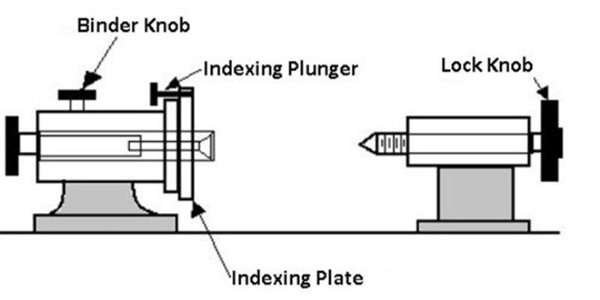
Útil de indexación CNC
Dispositivo de indexación CNC dispone de una función de rotación. Este dispositivo gira la pieza de acuerdo con los ángulos requeridos después de intervalos fijos. Con la ayuda de los útiles de indexación, no es necesario girar manualmente para hacer agujeros o ranuras en una pieza.
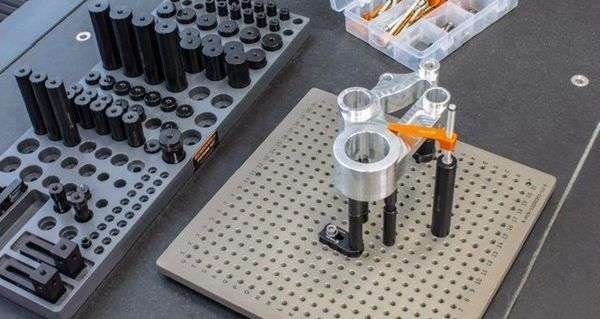
Fijación modular CNC
Accesorios modulares son lo suficientemente flexibles para ajustar diferentes piezas de trabajo con formas y tamaños variados. Le permite utilizar el mismo útil para diferentes piezas de trabajo sin necesidad de utilizar útiles distintos.
Escuadra CNC
Se trata de otra solución de sujeción de la pieza de trabajo. Como su nombre indica, una fijación angular ayuda a colocar la pieza de trabajo en cualquier ángulo específico. Tiene algunos componentes que ayudan a ajustar la pieza de trabajo en algunos ángulos para el proceso de mecanizado. Estas fijaciones ayudan a hacer filetes y chaflanes durante el mecanizado. Servicios de fresado CNC y perforación.
Fijación por vacío
Estas fijaciones utilizan la succión para sujetar con seguridad una pieza de trabajo y son beneficiosas para el mecanizado de piezas delicadas en la industria manufacturera. Algunas piezas son tan delicadas que no soportan la presión de las pinzas, por lo que necesitan fijaciones de vacío. Estos útiles colocan la pieza fina sobre una placa plana con orificios. La presión de succión se ejerce a través de los orificios. Estas fijaciones evitan la deformación o distorsión de productos delicados.

Fijación de palets
A fijación de paletas es una herramienta crucial para evitar la manipulación individual de varias piezas de trabajo en la industria manufacturera. Reduce el tiempo de manipulación durante los procesos de fabricación. Este útil tiene una plataforma robusta conocida como palet para sujetar muchas piezas de trabajo. Las fijaciones de palets facilitan el traslado de las piezas al siguiente paso de las operaciones de mecanizado.

Accesorios a medida
Fijación a medidas; Como su nombre indica, las fijaciones a medida ayudan a sujetar estructuras complejas. Son versátiles y pueden ser adecuados sólo para piezas de trabajo específicas. El diseñador de fijaciones repasa todos los requisitos según la pieza de trabajo y luego diseña una fijación que se adapte mejor a ese material.
Cada componente de una máquina tiene sus propios requisitos, y algunas piezas como orificios, ranuras y cajeras son difíciles de mecanizar. Para conseguirlo, las fijaciones personalizadas desempeñan un papel fundamental en todo el proceso.
Principios básicos para elegir la luminaria adecuada
Una fijación inadecuada aporta imprecisión a la tarea de mecanizado, provoca errores y disminuye la calidad del producto porque no puede sujetar y estabilizar la pieza. Por lo tanto, es necesario seleccionar los útiles adecuados para la pieza de trabajo. Algunos principios básicos ayudan a los operarios a elegir los útiles de mecanizado adecuados.
Consideraciones geométricas
La geometría de la pieza de trabajo es lo primero que hay que tener en cuenta al seleccionar una Fijación CNC. También debe tener en cuenta estos factores:
- Forma de la pieza: Para un posicionamiento y sujeción seguros, el útil debe coincidir con la forma y el tamaño de la pieza. Si no hay una coincidencia exacta, entonces no habrá un agarre firme de un accesorio en la pieza de trabajo.
- Accesibilidad: Durante el proceso de mecanizado, la herramienta de corte necesita un acceso específico a las distintas zonas de la pieza para obtener los resultados deseados. Cualquier restricción y la ausencia de un camino claro durante las operaciones de mecanizado pueden causar obstáculos en el mecanizado eficaz.

Consideraciones materiales
La compatibilidad y la estabilidad del material son importantes a la hora de seleccionar la fijación para la pieza de trabajo. Hay algunos puntos que debe conocer antes de seleccionar el material:
- Compatibilidad de materiales: Los requisitos de mecanizado de todos los materiales son diferentes. Puede utilizar un material como plástico, acero o aluminio en la máquina CNC; todos los materiales no tienen requisitos de fijación similares. Por lo tanto, es necesario tener en cuenta la compatibilidad de la pieza de trabajo con la fijación.
- Estabilidad y rigidez: El material de la fijación debe proporcionar estabilidad para evitar vibraciones durante las fuerzas de corte. Si el material no es rígido en función de la pieza, se producirán desviaciones.
¿Qué factores hay que tener en cuenta en el diseño de útiles CNC?
Las máquinas CNC han beneficiado a la industria manufacturera al reducir los costes de mano de obra y aumentar los índices de producción. Depende de las distintas herramientas de mecanizado. El diseño de herramientas como las fijaciones es un reto y requiere un amplio conocimiento de los procesos de fabricación e ingeniería. Hay algunos factores cruciales que debe tener en cuenta para Diseño de fijaciones CNC.
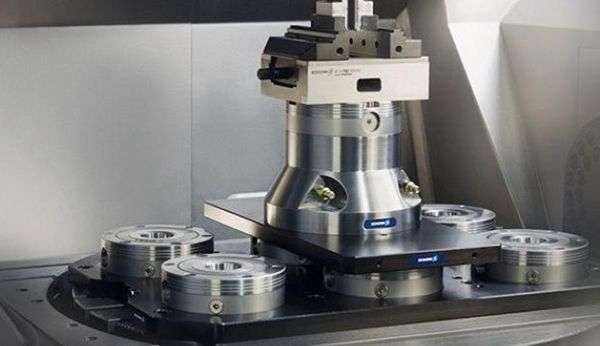
Tipos de máquinas CNC
Las diferentes máquinas CNC incluyen máquinas de 3 ejes, 4 ejes y Máquinas CNC de 5 ejes. Todas estas máquinas utilizan diferentes números de ejes para sus operaciones. Las máquinas de 3 ejes son las más comunes y utilizan los ejes X, Y y Z.
Pero en el mecanizado CNC de 4 y 5 ejes, interviene un eje giratorio adicional. Por tanto, al diseñar una fijación CNC, es necesario tener en cuenta el tipo de máquina para una sujeción adecuada en la superficie de la fijación.
Eficacia en la instalación y el vaciado de herramientas
El diseño de la fijación no debe ser complejo; debe ser sencillo para que el operario pueda fijarla rápidamente durante las operaciones de mecanizado. Tras el proceso de mecanizado, la holgura de la herramienta es necesaria para mantener la eficacia. Debe ser fácil de limpiar para evitar obstáculos durante el mecanizado.
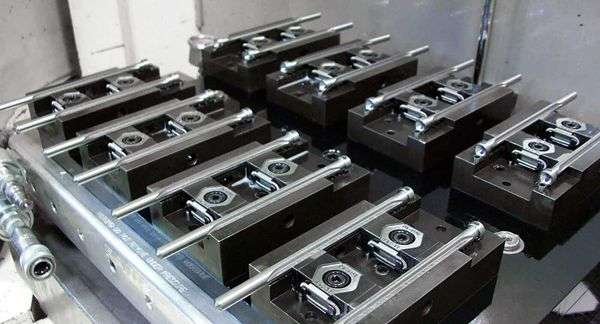
Producción de lotes pequeños y grandes
Los útiles diseñados para la producción de lotes pequeños y grandes varían en función de la flexibilidad y la máxima productividad. En la producción de lotes pequeños, es necesario cambiar las piezas con frecuencia. Su diseño debe ser capaz de ajustar piezas con diferentes especificaciones. En el caso de los lotes grandes, la producción es continua, por lo que sus utillajes deben permanecer estables durante más tiempo para cumplir los requisitos de las piezas de trabajo.
Aplicaciones de las fijaciones CNC en el mecanizado
Las fijaciones son una herramienta importante para el mecanizado CNC y desempeñan un papel vital en diferentes industrias, como la automovilística, la aeroespacial, la sanitaria y la electrónica. Todas estas industrias utilizan herramientas adecuadas para el mecanizado de diferentes piezas estructurales. Las fijaciones CNC sirven a las industrias manufactureras con una amplia gama de aplicaciones que incluyen:
Posicionamiento y sujeción
Las fijaciones proporcionan una plataforma estable para cualquier operación de mecanizado en la industria manufacturera. En primer lugar, los útiles colocan la pieza en la superficie de la máquina y garantizan la precisión de la operación. Por otro lado, la sujeción es el agarre de los útiles a la pieza.
Operación de montaje asistido
En la fabricación, el ensamblaje es vital para obtener un producto acabado. Las operaciones de ensamblaje suponen un reto y requieren una alineación y posicionamiento adecuados al unir diferentes piezas. Los dispositivos de sujeción de piezas CNC son esenciales porque sujetan las piezas firmemente y garantizan su ajuste correcto.
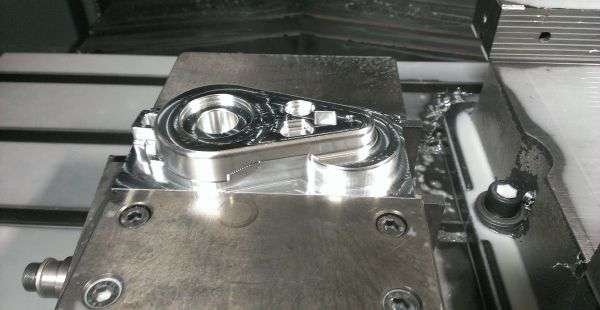
Operaciones de mecanizado
Las operaciones de mecanizado como el corte, el taladrado y el fresado requieren un cuidado y una manipulación adecuados. Cualquier negligencia puede provocar repeticiones, defectos y errores. Los distintos tipos de dispositivos de fijación CNC resuelven todos los problemas de las operaciones de mecanizado proporcionando soluciones de sujeción del trabajo a los operarios. operadores.
Inspecciones y pruebas
Las inspecciones y evaluaciones necesitan un posicionamiento adecuado de la pieza para seguir los procedimientos de prueba. Las inspecciones y las pruebas son pasos necesarios después de producir diferentes piezas en el mecanizado CNC. Garantiza que las especificaciones cumplen los requisitos. También ayuda a eliminar las piezas que no cumplen los requisitos.
Obtenga dispositivos CNC personalizados para sus proyectos en XinCheng Machining
En Mecanizado XinOfrecemos dispositivos de sujeción de piezas CNC eficaces y de alta calidad para sus proyectos. Nuestro cualificado equipo cuenta con Soluciones de mecanizado CNC que se adapten a sus piezas mecanizadas.
Así pues, si le preocupa la calidad o la eficacia de la producción de su unidad de fabricación, póngase en contacto con nosotros hoy mismo. Hablemos de sus necesidades y empecemos con los proyectos.
Conclusión
A accesorio es una herramienta útil para muchas operaciones de mecanizado que aporta estabilidad a todo el proceso. Así pues, para proyectos de mecanizado CNC complejos y con grandes requisitos, puede elegir útiles CNC para que sus piezas mecanizadas cumplan los requisitos de sujeción.
Preguntas frecuentes
¿Qué tipo de materiales pueden mecanizarse con útiles CNC?
Los útiles de mecanizado CNC son compatibles con acero, plástico, aluminio, cobre y titanio. Puede elegir un material en función de sus necesidades y requisitos.
¿Pueden las fijaciones CNC adaptarse también a la producción a gran escala?
Las fijaciones CNC son adecuadas tanto para la producción de lotes pequeños como para la producción de lotes grandes. Pero para su adaptabilidad, debe seleccionar los útiles adecuados en función de su pieza de trabajo.
¿Son caras las fijaciones CNC personalizadas?
Si invierte en útiles CNC, ahorrará costes a largo plazo. Racionalizar la producción es la mejor forma de ahorrar costes en la industria manufacturera. Por tanto, es mejor invertir una vez para obtener beneficios a largo plazo.
¿Cuál es la diferencia entre plantillas y utillajes?
Estas dos herramientas, plantillas y utillajes, son conocidas por sujetar firmemente las piezas de trabajo. Pero no son lo mismo. Las plantillas son fijas y no permiten que las piezas se muevan con la herramienta, mientras que los útiles pueden mover la pieza en la dirección deseada. Los útiles son más flexibles que las plantillas.

